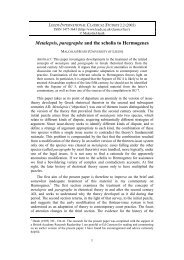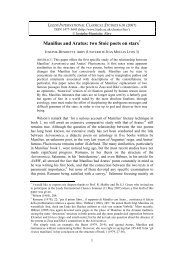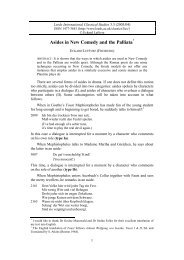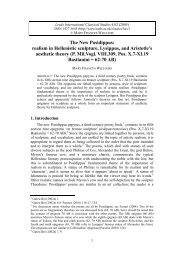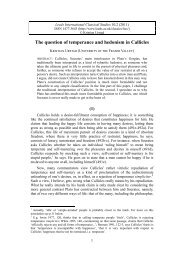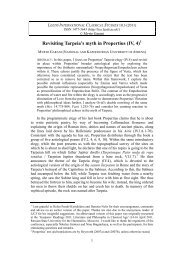Greek Tragedy between Human and Animal - Leeds International ...
Greek Tragedy between Human and Animal - Leeds International ...
Greek Tragedy between Human and Animal - Leeds International ...
Create successful ePaper yourself
Turn your PDF publications into a flip-book with our unique Google optimized e-Paper software.
CHIARA THUMIGER, GREEK TRAGEDY BETWEEN HUMAN AND ANIMAL<br />
of the dead body into that of a beast symbolises in all evidence the risk to which<br />
we are always exposed of the reduction of human to animal. 17<br />
The middle ground is also confirmed by the fact that human emotions<br />
themselves can be animalised: especially (but not exclusively) in the image of the<br />
bird. 18 We find states of violent mental or emotional affection, or even critical<br />
experiences represented as winged <strong>and</strong> feathered, <strong>and</strong> the subject as ‘flying<br />
away’—an exchange that underlines the equation <strong>between</strong> the animalised subject<br />
<strong>and</strong> the animalised emotional affection. 19 In Aesch. Su. 329 pain is a winged bird,<br />
‘varied is human suffering, you could not find two pains with the same feathers’,<br />
taÙtÕn pterÒn; at IT 571, dreams are winged <strong>and</strong> untrustworthy, pthnîn<br />
Ñne…rwn. 20 In Sept. 597 voluble destiny is imagined as a bird, feà toà<br />
xunall£ssontoj Ôrniqoj broto‹j; 21 the Erinyes are represented as winged (e.g.<br />
Or. 276; IT 289); likewise, Hades is winged (Alc. 262); 22 escape <strong>and</strong> regret are<br />
connected to flight (at Or. 1593 Menelaus mocks Orestes, ‘you won’t rejoice,<br />
unless you have wings to fly away’, ½n ge m¾ fÚgVj ptero‹j; at Ag. 394, the<br />
guilty ‘runs after a bird’s flight’, dikaiwqe…j, peˆ dièkei | pa‹j potanÕn<br />
Ôrnin). 23 o stroj, ‘gadfly’ <strong>and</strong> cognates for madness <strong>and</strong> distress is also relevant,<br />
from the literal instance with reference to Io’s myth (PV 566, IT 394, Aesch. Su.<br />
17<br />
The motif of cannibalism <strong>and</strong> teknophagy, akin to that of animals eating cadavers, is relevant<br />
here as exposition of a contiguity <strong>between</strong> human <strong>and</strong> animal. Forbes Irving (1990) 103 connects<br />
this mythological element to incest <strong>and</strong> familial disorder. This motif is present in the tragedians,<br />
<strong>and</strong> does signpost familial transgressions (the feast of Thyestes, at Ag. 1584, 1588, 1242, Ch.<br />
1069, Or. 1008, Eur. El. 10, 613, 719, 773, IT 812, engendering the chain of murders within the<br />
house of Atreus; the myth of Tereus <strong>and</strong> Procne at Aesch. Su. 62, qualifying the struggle <strong>between</strong><br />
the Danaids <strong>and</strong> their cousins, <strong>and</strong> at HF 1021, to contrast Heracles’ unwitting slaughter of his<br />
own children).<br />
18<br />
See Padel (1992) 114-61 for an account of ‘zoology’ <strong>and</strong> ‘daimonology’, where animal is used<br />
to define the human <strong>and</strong> acts as a daemonic presence ‘invading man at all points’ (150). Padel<br />
connects her analysis to the representation of human feeling <strong>and</strong> experiences as externalised; I<br />
prefer to shift the focus on animals as free-st<strong>and</strong>ing items alongside man.<br />
19<br />
Tragic language offers verbs such as taurÒw (‘to turn into a bull’, expressing strong emotions<br />
<strong>and</strong> affections: Cho. 275, Me. 92), kdrakontÒomai (for Orestes embracing his doom of revenge,<br />
Ch. 549); pštomai at Ba. 214 <strong>and</strong> 332, with reference to Pentheus’ irascible temper <strong>and</strong> then<br />
derangement (cf. Seaford 2001, 170-71 on line 214 on ‘fluttering nervous excitement’ as one of<br />
Pentheus’ experiences which reflect initiation into the Dionysiac mysteries. For initiatory ptÒhsij,<br />
‘excitement’, Seaford compares Plut. Mor. 943c, Arist. Quint. De Mus. 3.25, Pl. Phd. 108b1, Ar.<br />
Nu. 319).<br />
20<br />
Relevant here is also the adjective ÐmÒpteroj, ‘having the same plumage’ to signify proximity,<br />
familiarity or similarity: at Pho. 328 Oedipus is ÐmÒpteroj, in his grief, to one who sees two<br />
horses (his children) leaving the yoke; at Cho. 174 the hair of Orestes <strong>and</strong> Electra are ÐmÒpteroj<br />
(<strong>and</strong> likewise at Eur. El. 530).<br />
21<br />
Likewise, at HF 1186, the subject hit by misfortune is ‘winged’, <strong>and</strong> carried away on wings,<br />
o„cÒmeqa ptano….<br />
22<br />
Compare Hi. 828, where Phaedra ‘flies to Hades’.<br />
23<br />
Flight is especially relevant to ‘escape choruses’: see also Hi. 733, where the chorus wishes they<br />
could fly away, a stock expression for grief, fear <strong>and</strong> regret; similarly, Hermione at Andr. 862, ‘I<br />
wish I could be a bird [<strong>and</strong> fly away]’; at IT 1141 the chorus long for escape, n nètoij ¡mo‹j<br />
ptšrugaj l»xaimi qo£zousa; at HF 649-54 the chorus hopes old age would fly away, gÁraj...<br />
ptero‹si fore…sqw.<br />
7



